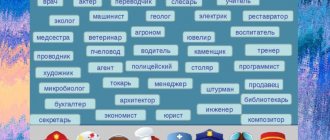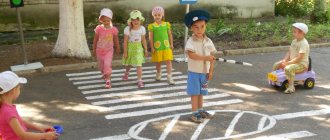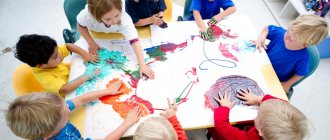Techniques for conducting musical and didactic games with children aged 1.5–4 years
As in working with any other material, the teacher uses 3 groups of techniques to conduct musical and didactic games.
Verbal techniques
The formation of speech skills at 1.5–4 years is a priority area for the development of children. If in the first younger group children are just beginning to express themselves in individual words and simple sentences, then in the second group their skills are significantly enriched, the children are actively mastering the grammatical structure of speech. When working with one or another age category of pupils, it is important to provide children with the opportunity to hear spoken speech in order to form their own speech image.
This is interesting. Games with music allow you to enrich the timbre and dynamic characteristics of children's speech.
Explanation, conversation
These techniques are used on two levels: firstly, to introduce the characters of the game, and secondly, to clarify the game rules. In addition, the teacher talks about the music that accompanies the game. In this case, the story is built on the basis of a conversation: the teacher indicates the name of the work, and then asks the children questions of a reproductive nature regarding the tempo and mood of the melody (“Is this music fast or slow?”, “Is the melody sad or happy?”).
The explanation can be carried out on behalf of the game character, that is, a toy
Riddles and poems
Any type of activity requires motivation of kids. Especially if we are talking about younger preschoolers who do not yet have the ability to concentrate their attention at the request of the teacher. One of the best ways to motivate children to work and not drag out this process for a long time is riddles and poems. Since the plots of most games are related to animals, the material is selected according to the topic.
So, before playing the game “Who Lives in the House,” in which each resident of the house corresponds to one or another instrument, I offer my students the following riddles about the heroes of the game:
- He slept for a long time all winter, sucked his right paw, and woke up and began to roar. This forest animal... (Bear).
- What is before us? A miracle with long ears, he jumps and hops along the path, like a soft ball. Who is this? Guess it! Well, of course, this is... (Bunny).
- An important gait, a red beard, spurs, a scarlet comb, This is Petya... (Cockerel).
This is interesting. When working with younger preschoolers, it is better to select riddles with agreements, so that it is easier for children to navigate when choosing an answer according to the rhyme.
Poems are also selected according to the plot; they should not be too long, otherwise the children will become distracted and it will be difficult to get them to work.
In my personal practice, I introduced poems before games that involved musical instruments. Children especially like rhymes with imitation sounds:
- Drumming the drum, Bam-bam-bam and bam-bam-bam. Very loud, I know it myself, Bam-bam-bam and bam-bam-bam, The drum is drumming, Bam-bam-bam and bam-bam-bam.
- Doo-doo, doo-doo-doo, I blow my trumpet. I can be a trumpeter, doo-doo, doo-doo-doo.
- Three strings in total, shake and shake. The tool is known to us. I'll take the balalaika and start the dancing one.
- Damn it, I took the guitar, I didn’t know how to play it. Let dad teach me - I will be the best guitarist.
Poems with imitation sounds help children remember the sounds of instruments
Short stories
Stories and stories on the theme of the game perfectly illustrate the game. In my practice, I use such fairy tales, invented on the fly, to unite the heroes of the game with those game actions that are assumed by the conditions. For example, for the game “Forest Orchestra,” in which kids identify an animal by the sound of a musical instrument, the story could be like this: “Once upon a time there was a Bunny. He really liked the way the birds sing, but when he tried to repeat their melodies, he got some strange sounds. And then the wise Owl advised Bunny to go to the market and buy a pipe. So he did. I began to play, and the forest animals also wanted to learn to play musical instruments. The Bear went to the market and bought a drum, the Wolf took a tambourine the next day, and the Fox learned to play the piano. And it turned out to be a real forest orchestra.”
Read also: Outdoor games in the preparatory group of kindergarten
Visual techniques
As already noted, visibility is an indispensable attribute of any type of activity for preschoolers.
Printed materials and pictures
For musical educational games this is:
- images of musical instruments,
- booklets (folding books containing pictures of game characters),
- drawings or coloring pages based on game plots,
- puzzles, lotto with images of musical instruments.
Lapbooks
For children of the second youngest group, who already have some ideas about music, a current visual device is a lapbook - a homemade folder with materials for games on a specific topic, for example, “New Year holidays”, “Spring has come”, etc. Children consider such materials , discuss with the teacher.
A lapbook can store materials for some musical and educational games.
Demonstration
An approach that involves:
- watching a video showing game actions,
- demonstration by the teacher of all game movements (especially if these are outdoor games),
- showing presentations about musical instruments.
This is interesting. Children of primary preschool age are characterized by imitation in movements, so you can demonstrate play actions on behalf of children’s favorite toys, for example, glove puppets.
Interactive musical and didactic games
One of the most popular demonstration techniques is interactive musical and didactic games: an animated video reveals the essence of game actions and leads to the essence of the task.
Kids enjoy watching games on the multimedia screen, quickly getting involved in game actions
Video: musical and didactic game “Sun”
Props
Of course, when conducting musical and didactic games for playing music, you cannot do without instruments. Kids should have an idea of the visual image of the instrument that is mentioned in the game. The availability of tools is determined by the material and technical base of the preschool educational institution, but, as a rule, kindergartens have:
- piano,
- drum,
- tambourine,
- pipe,
- guitar,
- xylophone.
These instruments allow children to gain an understanding of the variety of musical sounds. Attributes for games are part of the musical corner of the subject-development environment in the group.
This is interesting. The music area should also feature portraits of composers whose works children listen to in class (Tchaikovsky, Kabalevsky, Mozart, etc.).
The music corner introduces children to a variety of instruments for playing music.
Practical techniques
Usually these techniques are used as a kind of reflection after the game: children draw characters, make applications, and crafts on the topic. In the first junior group, this work is reproductive in nature: the children repeat what the teacher demonstrates (glue, paint, sculpt). In the second younger group, pupils show more creative independence: they no longer just paint, but draw, not only glue appliqué elements, but also place them on the base themselves, etc.
In my work in the second junior group, I invite children to create projects together with their parents that introduce musical instruments. Students choose any instrument, draw it or paste a photo, select riddles, poems, fairy tales about it, and also find interesting facts from history.
Making musical instruments by children together with their parents is a very interesting practical technique.
Progress of the game:
The teacher invites the children to go for a walk in the clearing drawn in the picture : “Little bunnies live here, and you will find out what they do when you listen to the music . The melody of a lullaby or dance music , the children identify it and insert it
4. Games for genre identification and memory development
4.1. The song came to visit
Goal: Develop musical memory .
Game material: Magic bag and toys, characters from children's songs.
Progress of the game: The teacher brings a magic bag to the group, examines it, and makes assumptions about what it could be.
Educator: The song came to visit
And she brought a gift.
Come on, Tanya, come over,
What's in the bag, look!
The child takes a toy out of the bag. The teacher offers to remember the song in which this character appears: cat, mouse, horse, bunny, car, bird, etc. The teacher invites the children to sing the song individually, in choir or ensemble.
Note: The song is not necessarily about a toy. The hero may simply be mentioned in a song.
4.2. "Wonderful bag"
Game material. A small bag, beautifully decorated with applique. It contains toys: a bear, a hare, a bird, a cat, a cockerel. You can use characters from the puppet theater (Fig. 6)
.
Progress of the game. The whole group participates. “Children,” says the teacher, “guests came to our lesson. But where did they hide? Maybe here? (Shows the bag.)
Now we’ll listen to
the music and find out who’s there.” The music director plays melodies of works familiar to the children: “Cockerel”
- a Russian folk melody,
“Grey Cat”
by V. Vitlin,
“Sparrows”
by M. Krasev,
“Bear”
by V. Rebikov, etc. Children recognize
the music , one of them gets from the bag the corresponding toy and shows it to everyone.
4.3. "Find a toy"
Game material. Toys corresponding to the content of the songs: bunny, bear, cat, cockerel, etc.; laptop with recordings of program works.
Progress of the game. The toys are on the table. Children sit in a semicircle. The teacher offers to listen to the melody and choose (says the child’s name)
appropriate toy.
The game ends when there are no toys left on the table. The game can be played in class to reinforce familiar works and in free time from classes (preferably in the afternoon)
.
5. Emotional perception of music .
5.1. "Walk"
Equipment: flannelgraph and cards depicting short and long sounds.
How to play: Wide cards correspond to long sounds, narrow cards to short ones.
Example: Tanya took the ball and began to slowly hit the ground.
“It began to rain frequently and heavily”
children quickly clap their hands and lay out narrow
,
etc. d. 5.2. “Who went out for a walk?”
Goal: To present an appropriate image to the music and convey it in motion.
Progress of the game:
An adult begins a fairy tale:
“There is a little mansion in the field,
He is not short, not high, not tall.
Is there someone running across the field towards the house?
Here across the field, is someone in a hurry to the house?”
Children listen to music and determine which fairy tale character by the sound.
she comes up. A child who correctly guessed whose music is playing ,
goes out to the playing field and inserts the corresponding figure of the fairy tale hero into the slot in front of the house.
2. Development of dynamic hearing
2.1. "Silent and loud bells"
Goal: to develop dynamic hearing.
Game material: rattles or noise toys according to the number of children.
Game "Bells"
Kindergarteners of the middle group are playing. For the lesson you need to prepare a box with rattles.
The purpose of the musical-didactic game “Quiet and Loud Bells” is to develop musical hearing and perception of sounds of different heights.
Tasks:
- learning the ability to distinguish between soft and loud sounding music;
- learning the skill of playing musical instruments quietly and loudly;
- development of concentration;
- nurturing interest in music and musical instruments;
- training in teamwork skills.
Pupils examine rattles. The rule of the musical-didactic game “Loud-quiet”: when the teacher plays music quietly, the children should play the same way. When the teacher starts playing loudly, then the children should rattle the rattles louder.
The teacher begins to play music, the students rattle their toys to the beat in accordance with the strength of the sound. Then the teacher complicates the task: he begins to sing, and the participants, based on the strength of his voice, must determine how to shake the rattles.



